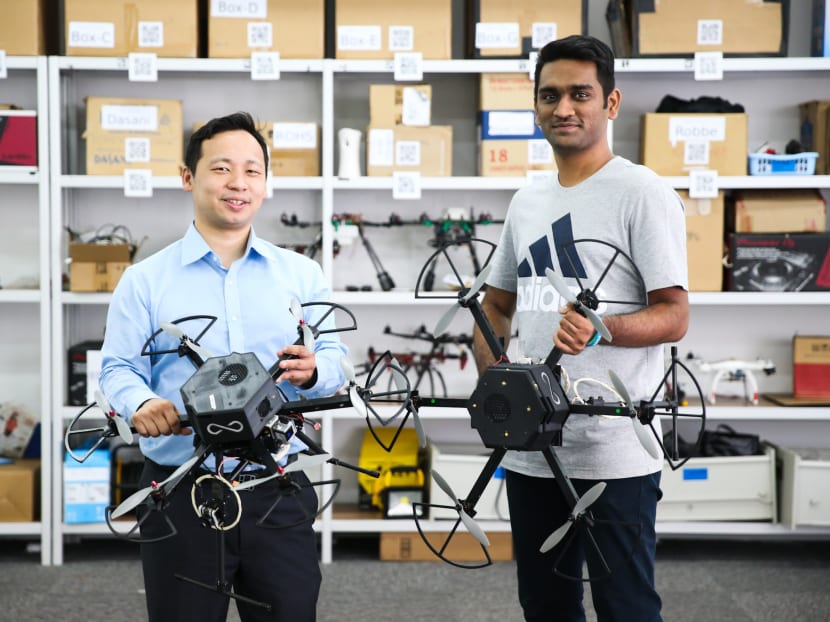The Future of Work: The brains behind robots that package goods, take stock at warehouses
SINGAPORE — In 2010, Temasek Polytechnic student Ganaventhan Thiagarajah and four of his teammates spent six months creating a "fighting robot" that would battle it out against others of its kind in an inter-polytechnic robotics competition. Though they did not win, Mr Ganaventhan deepened his interest in robotics, and would later build his career in this field. "That was the trigger, because we spent a lot of time on the project, and I became fascinated with it," the 30-year-old recalled.
Late last year, a study by consulting firm McKinsey estimated that almost a quarter of work activities in Singapore could be displaced by 2030. At the same time, however, a vast amount of jobs will be created, with new technologies spawning many more jobs than they destroyed, the study pointed out. The introduction of the personal computer, for example, has enabled the creation of 15.8 million net new jobs in the United States in the last few decades, even after accounting for jobs displaced.
In a new weekly series, TODAY looks at The Future of Work — the emerging jobs fuelled by technological advancements which may not even have existed a few years back, but are set to proliferate within the next decade or so. In the eighth instalment, we feature the engineers and entrepreneurs working in the robotics field.
SINGAPORE — In 2010, Temasek Polytechnic student Ganaventhan Thiagarajah and four of his teammates spent six months creating a "fighting robot" that would battle it out against others of its kind in an inter-polytechnic robotics competition.
Though they did not win, Mr Ganaventhan deepened his interest in robotics, and would later build his career in this field. "That was the trigger, because we spent a lot of time on the project, and I became fascinated with it," the 30-year-old recalled.
After graduating with a diploma in electrical engineering, he worked as a test engineer at a company that was a small- and medium-sized enterprise. His job was to design test processes to improve the efficiency of microphone circuits that could be fitted into mobile phones and headsets.
Looking to find greater challenges, Mr Ganaventhan made the jump to a United States-based firm Adept Technology, which specialised in automated robotics and its use to package products.
When Adept Technology was acquired in 2015 by Japanese firm Omron Asia Pacific, Mr Ganaventhan remained as an employee. There, he was exposed to various industries because, among other things, the firm produced biometric sensing technology to monitor health indicators such as blood pressure as well as automated robotic arms that could package items such as cosmetic products and precisely cut semiconductor components.
As projects engineer at the firm's automation engineering department, Mr Ganaventhan's role was to improve the precision of the robotics equipment.
"It was definitely more fulfilling, because you don't just work on one project for one industry. It's across various industries. What's important is that I keep on learning," he said.
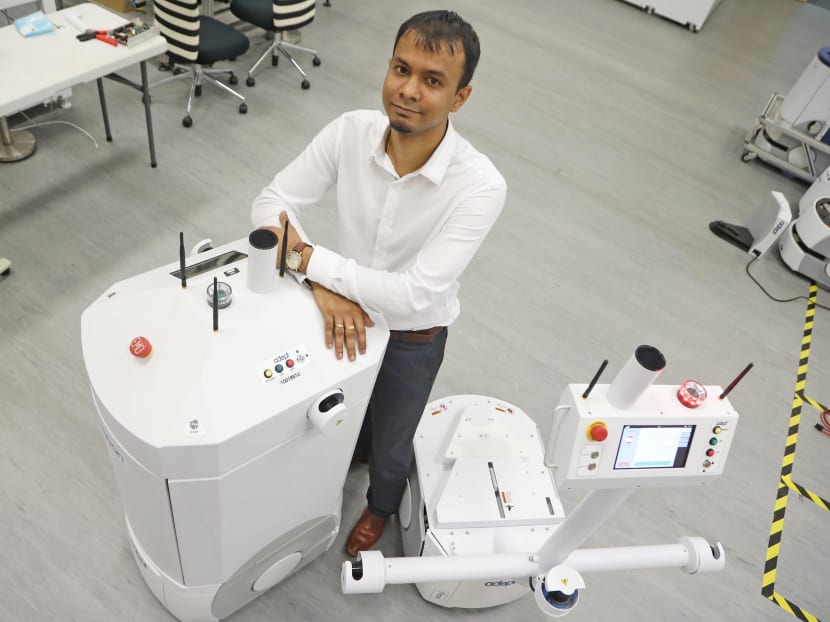
Last year, Mr Ganaventhan received a degree in electronics engineering from the National University of Singapore through part-time studies.
Recently, he was roped in to work on a new project: Producing an augmented reality application that gives the firm's clients an idea of how their various products work, without them having to physically view the equipment.
"There's a sales role involved, and it's good for me because it expands my career path," he added.
Adapting to changes fast is par for the course of when it comes to building and working with new technology. The motto appears to be that slow and steady does not win the race.
Getting to test products quickly, the rush of beating competitors to market the products, adding new or improved features to the products to stay competitive, repackaging them across industries, and carving a niche for the enterprise are just some of the reasons why those in the robotics business find their jobs appealing.
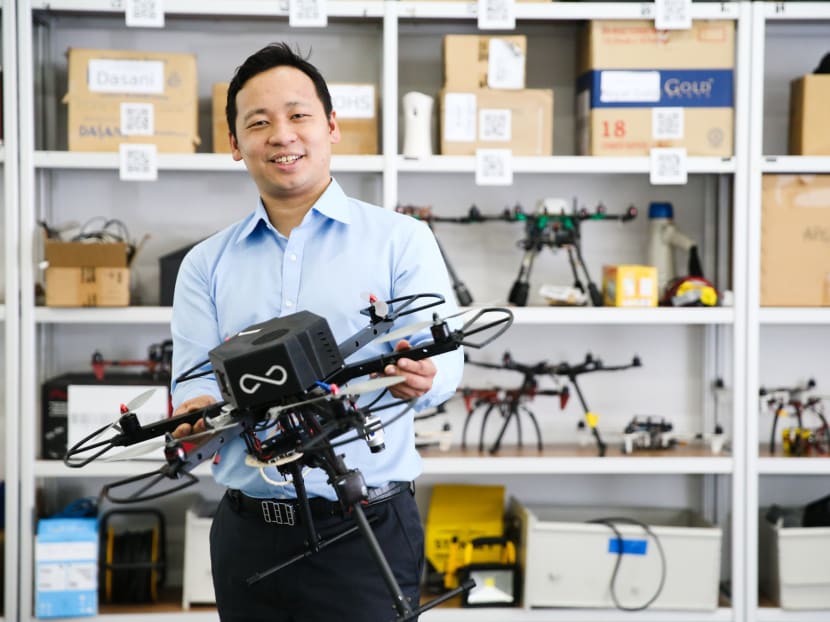
When Mr Woon Junyang set up his robotics start-up Infinium Robotics in 2013, there were not many Singapore and international players in the scene. In the last three years though, competition has been heating up, with more homegrown start-ups doing similar work, the 35-year-old said.
This forced companies, including his, to narrow their focus, specialising in areas such as creating autonomous vehicles, artificial intelligence software or creating augmented reality tools.
"You need to have a niche to stand out," Mr Woon said. His firm, which has just seven employees, first gained media attention when it piloted autonomous flying robots that could serve food and drinks at eateries.
He still uses these robots, but for a different purpose: To do stocktaking of goods at warehouses.Since the flying robots could not be fitted with a global positioning system (GPS), which does not function well indoors, they are guided by automated ground robots through sensors. These automated ground robots are programmed with the layouts of the warehouses so that they can navigate the ones overhead.
To scan the barcodes of goods for stocktaking, the flying robots are fitted with cameras as well as light detection and ranging technology, otherwise known as Lidar technology, to give them a guide on their surroundings.
If a warehouse is as big as half a football field, Mr Woon said that his flying robots can complete stocktaking within eight to 12 hours, as opposed to having 50 people doing the same job in three days.
He noted that his product has been piloted in warehouses in countries including Malaysia, Singapore and South Africa. The firm is now in sales talks with their partners.
"Instead of churning out multiple products of different nature, we try to build on our specialty," Mr Woon said. "For instance, we are looking to create a similar product that can operate in freezing temperatures so that it can do stocktaking for frozen meats."
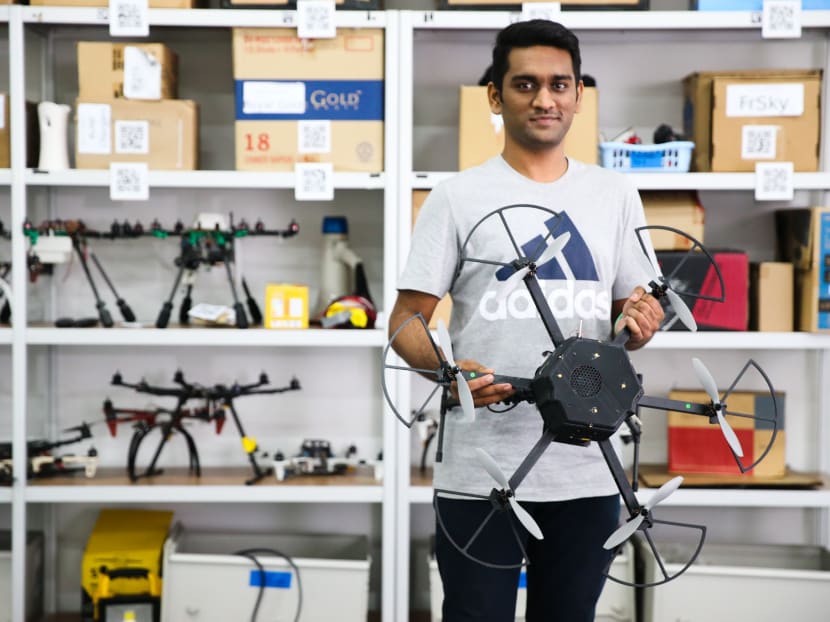
Joining Infinium Robotics just a month ago as a flight control engineer was Mr Siddharth Patel, 24, who has a bachelor and master's degree in aerospace.
Mr Patel's job is to programme the software used by the autonomous ground robots, so that they can properly guide the flying robots or drones around the warehouse.
He also has to take the details found on the barcodes of the goods and input them to the software used by the drones, so that they can capture the details accurately when they do stocktaking.
There have been times when tests have gone wrong. Mr Patel recalled one time when a development drone failed to read the sensors of the ground robot, and fell from a height of about four-storeys. "It just disintegrated," he said.
Each development drone, which is used for tests, costs less than S$100.
Given his love for aircraft and his field of study in university, why did he choose to join a start-up instead of global giants such as Airbus or Rolls Royce?
Mr Patel said that a start-up allows him to create and test a product in the market at a faster rate.
"Some would go for renowned firms, but it doesn't matter to me. What's exciting to me is that rolling out these new products is a race — who can implement them first. And I think start-ups are usually the first to do it because they're nimble."
Being agile and having the resources to build and rebuild a product or application is a way for firms dealing in robotics to stay ahead of the increasing competition.
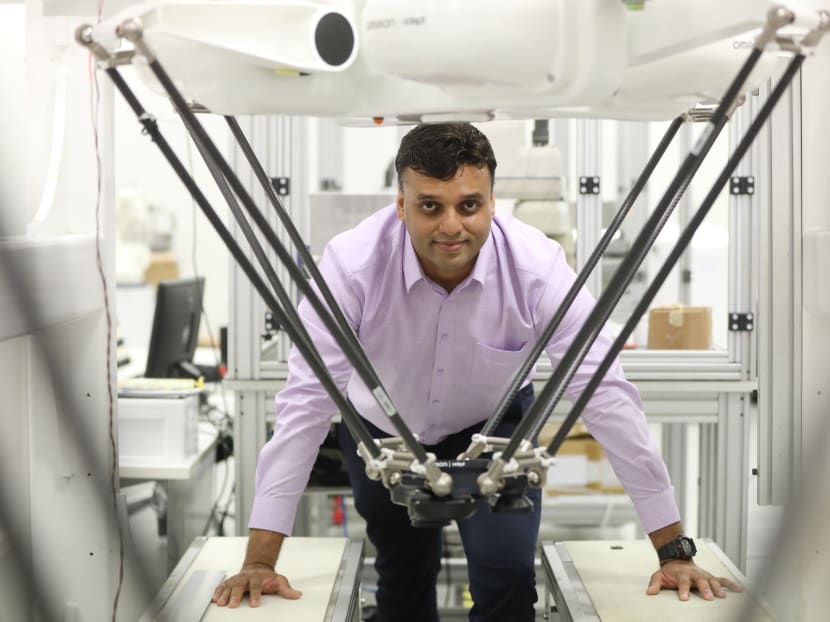
Mr Pragaasam Ramalingam, 39, manager for automation applications at multinational corporation Omron Asia Pacific, has been fine-tuning its products, such as its enhanced collaborative robots.
These robots, which typically packages products, used to malfunction when they came into contact with humans. With improvements, the robots will stop when they detect humans and let them pass before resuming work. They are set to be rolled out next month.
"You have to constantly be on your toes or the competition will eat into your pie," Mr Pragaasam said.
For Mr Woon, the biggest stumbling block is not so much the competition from other firms in the robotics field, but the financial health of companies acquiring their products.
Robotics equipment is supposedly more cost-efficient, but if companies want to reduce their overheads, they would not see a need to acquire the technologically advanced products, he explained.
"But in any situation, start-ups have the advantage to adapt to the needs of the industries. Because we're small and don't earn a huge revenue, if a product doesn't work or is not in demand, we can switch to other products easily," he said.

